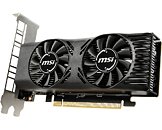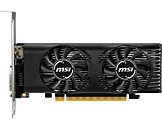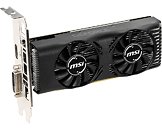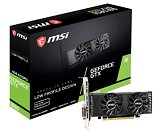Sunday, June 23rd 2019

MSI Releases a Low-profile GeForce GTX 1650 Graphics Card
MSI released one of first low-profile (half-height) graphics cards based on the GeForce GTX 1650. The card uses a monolithic aluminium heatsink that's ventilated by two 60 mm fans. Although there's just one row of display outputs, the cooler is over 1 slot thick, and so you get dual-slot I/O shields for both full-height and half-height (low-profile). The card relies on the PCI-Express 3.0 x16 slot for all its power, and sticks to NVIDIA-reference clock speeds of 1665 MHz boost, and 8.00 GHz (GDDR5-effective) memory. Based on the 12 nm "TU117" silicon, the GeForce GTX 1650 features 896 "Turing" CUDA cores, 56 TMUs, 32 ROPs, and a 128-bit wide GDDR5 memory interface, holding 4 GB of memory. Display outputs on this MSI low-profile card surprisingly lack DisplayPort, you only get an HDMI 2.0b, and a dual-link DVI-D (lacks analog D-Sub pins).




14 Comments on MSI Releases a Low-profile GeForce GTX 1650 Graphics Card
This should be reasonably big to allow for triple display output, ditching the DVI for a DisplayPort, or even 2
Not like others manufactures sometimes like filling the rear I/O up with ports and tiny ventilation like if they stock 2 normal DP or HDMI ports on top of each others.
But I get what you are talking about still adapters even original can solve this issue.
1080p VRR monitors are usually just TN panels and I don't think 1650 is particularly good choice any higher resolution than that. So while yeah it should have DP, it's not necessary the most important video output that can't be dropped. HDMI is a must for UHD tellies for htpc usage, DL-DVI is must for old monitor users with higher than 1200p@60Hz.
I wonder what drives the port adoption, since someone lounging on an old 1600p display doesn't seem like a likely candidate for a low profile version of the smallest Turing chip. Specifically, someone with a 2560x1600 display that only had DL DVI input, not DP - DP was present even on my old Dell U2711. For older monitors, we are talking about the Apple Cinema Display and the Dell 3007WFP, and that's almost the entire range of monitors where DL-DVI would be a benefit because DP ports were absent on that monitor. In Apple's case, they were "being Apple" and only wanted a single video input attached to their proprietary power/video mux box, so DP didn't make the cut. For the Dell, it came out 4 years prior, when Displayport didn't even exist.
It's such a limited use case, whereas DP would have covered a larger range of operation. Gsync (and Freesync) really bring the most benefit to lower end GPUs, IMO.
Two slotter with DP, HDMI, DL-DVI video outputs.